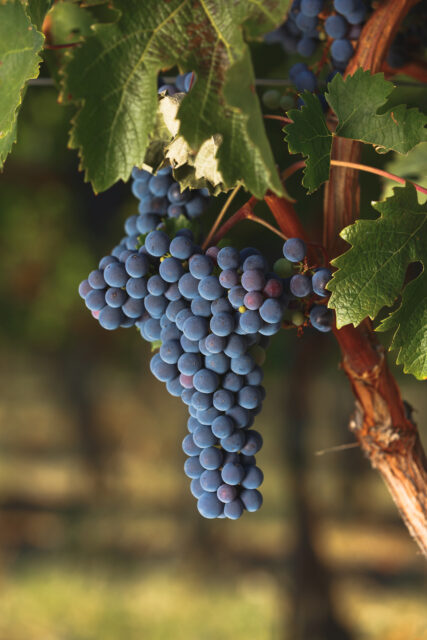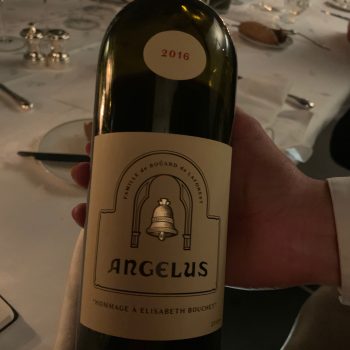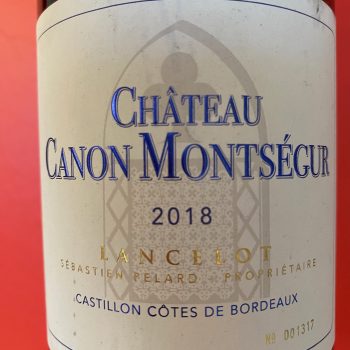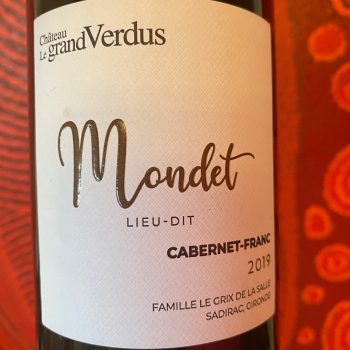The monocépage wines of Bordeaux: Part III – Cabernet Franc
In the third of a series of articles on the monocépage wines of the Bordeaux region, db’s Bordeaux correspondent Colin Hay explores the most aromatically expressive of all Bordeaux varieties, Cabernet Franc.

Cabernet Franc has something of the reputation of being the perennial bridesmaid yet never the bride – an accompaniment at best, rather than the star attraction.
Like most such reputations, the judgement is not entirely false – but it is certainly harsh. For in Bordeaux, at least (and arguably not just in Bordeaux) Cabernet Franc, even in small proportions, can bring a subtle and sublime beauty, lift and elegance to a wine. And in that respect at least, it is as it remains something of an insider’s grape variety. Knowing that it is in the blend often helps explain the character – and indeed the quality – of the wine in the glass. Knowledge of its presence is reassuring to those who know it’s there and to those who know to look for it.
As this already suggests, Cabernet Franc is rare on its own. It tends to appear widely in monovarietal form, in France at least, only in the Loire in the wines of Anjou, Bourgeuil, Chinon and, perhaps most famously, Saumur-Champigny.
In Bordeaux it is almost always accompanied by Merlot and, albeit less frequently, by Cabernet Sauvignon. As a varietal it is certainly more and more appreciated, above all on the right-bank. But even here it is rarely a star, appearing only exceptionally as the majority variety in the blend – in, for instance, the Saint-Émilion’s Le Dôme and Jean Faure.
And on the left-bank it plays not even second fiddle to Cabernet Sauvignon, but third or more frequently fourth violin, behind both Merlot and Petit Verdot too. Here it tends to be less noted and less appreciated, appearing in the vineyard it is often assumed simply because it is a little easier to ripen than the star-turn Cabernet Sauvignon with which it vies for vineyard space.
Yet, as that in a sense implies, it is a variety used throughout the Bordeaux region – as is clear from the geographical range of the monovarietal expressions sampled below.
On its own, it is typically delicate and floral. It brings finesse, elegance and a sense of refinement. But it is crucial that it achieve perfect ripeness and is not over-cropped. Where it doesn’t, it is vegetal and even where it does it can bring herbal and borderline vegetal notes, even to a blend. Aromatically it is supremely expressive in its floral youth and, alongside Cabernet Sauvignon in particular, it accentuates the notes of cedar, graphite and walnut so redolent of Bordeaux classicism. It is recognisable too in its distinct crushed rose and green peppercorn notes.
As a variety it fares exceptionally well on clay and clay-limestone, being perhaps at its best on the argilo-calcaire soils (or base rock) of the plateau and côtes of Saint-Émilion and on the clay of the plateau of Pomerol. But it is versatile and it adapts well to a range of Bordeaux terroirs – limestone, clay, gravel and sand.
It is lighter, in general than Cabernet Sauvignon (both in colour intensity and palate density). With thinner skins and a little less tannin, it is also somewhat less age-worthy than its more illustrious near namesake.
Records show that it was planted quite widely in the Bordeaux region (under the local name, Bouchet) from at least the 18th century, predominantly in Fronsac, Pomerol and Saint-Émilion. But it was present in the region long before. Indeed, it was from Bordeaux that Cardinal Richelieu brought the first cuttings of Cabernet Franc to the Abbey of Bourgeuil almost a full century earlier.
It is a parent of Cabernet Sauvignon, Merlot and Carménère, though viticulturally similar to its most famous progeny, Cabernet Sauvignon. Its principle viticultural difference is that it buds and ripens a little earlier, allowing it to be grown (as in Pomerol and Lalande de Pomerol) in vineyards where Cabernet Sauvignon is unlikely to attain full maturity on a reliable basis.
Today it is the seventh most planted grape variety in France (after, Merlot, Ugni Blanc, Grenache, Syrah, Chardonnay and Cabernet Sauvignon according to the International Organisation of Vine and Wine (OIV)), at just 4.1% of total production (in comparison to Merlot’s 14%). Indeed, overall production in France is similar to that for Cabernet Sauvignon. But it is much more localised, with significant planting largely restricted to the Loire, the right-bank of the Gironde, Bergerac and Madiran.
Though rarely dominant in a Bordeaux blend, it so often seems to define the personality of some of the region’s greatest wines. Like Petit Verdot, if in a rather different way, a little goes a long way. Yet in a number of superstar Saint-Émilions it is either in the ascendancy or between a third and a half of the final blend. In the former category we have, perhaps most famously, Jonathan Maltus’ micro-cuvée Le Dôme (invariably 80% of which is Cabernet Franc) and Jean Faure (at around 60-65%). What many also forget is that most recent vintages of Ausone itself have Cabernet Franc in the ascendancy (the 2021 and 2019, for instance, are both at 65%).
In the second category, at between 30% and 50% of the blend, we find Cheval Blanc (a wine whose excellence has almost become synonymous with the variety), Angélus (where the share of Cabernet Franc has risen steeply in recent vintages) and Figeac (typically, a blend of roughly equal parts of Cabernet Sauvignon, Cabernet Franc and Merlot). Yet we also have Pavie and a clutch of former or current Premier Grand Crus Classés and other plateau stars such as La Gaffelière, Canon, Berliquet, Beauséjour and Rocheyron.
In Pomerol, there is only one wine – Lafleur – in which Cabernet Franc is ever the largest single component (with Bouchet representing 54% of the final blend of the legendary 2015 for instance). But other than at Petrus, Le Pin and, in some recent vintages, Trotanoy, it is integral to the identity of the leading wines of the plateau, even if rarely at more than 30 per cent of the final blend.
In Pessac-Léognan the overall proportion of Cabernet Franc in the final blends of the grands vins is smaller. But the variety has a seeming close and natural affinity with vineyards baring the Haut Brion epithet, most notably Les Carmes Haut Brion (where Cabernet Franc is the largest single variety, even if never at more than 50% of the blend).
It is really only in the Médoc, then, where Cabernet Sauvignon is the undisputed king that Cabernet Franc is less significant to the identity of the leading wines. It appears scarcely at all in the final blends of the Médocain first growths other than in Margaux (where it rarely exceeds 3% of the final blend). Yet even here there are a number of exceptional wines whose identity owes much to the presence of Cabernet Franc in the final blend – Léoville Las Cases, Léoville Poyferré, Pichon Comtesse de Lalande, Calon-Ségur and du Tertre (where it typically exceeds 20% of the final blend) being perhaps the most notable.
Figure 1: the proportion of Cabernet Franc in the final blend of leading crus (2021 and 2020 vintages, respectively).
Partner Content
- Saint-Émilion: Le Dôme (80; 80); Jean Faure (60; 65); Ausone (65; 50); Angélus (60; 40); Cheval Blanc (52; 30); Berliquet (39; 34); CLG (45; 30); La Gaffelière (42; 40); Rocheyron (40; 20); Lassegue (36; 35); Figeac (31; 32); Quintus (31; 37); Pavie (30; 34); Dassault (30; –); Canon (29; 33); Beauséjour (27; 17).
- Pomerol: Lafleur (48; 46); Pensées de Lafleur (41; 29); Nenin (36; 32); Beauregard (30; 35); Certan de May (30; 25); Evangile (30; 12); Clos du Clocher (30; 25); Petit Village (26; 32); Hosanna (25; 25); Rouget (20; 20); Vieux Château Certan (20; 15); La Conseillante (15; 13); l’Eglise-Clinet (15; 10).
- Pessac-Léognan: Les Carmes Haut-Brion (40; 40); Haut-Brion (12; 17.5); Larrivet Haut-Brion (19; 6); La Mission Haut-Brion (6; 8).
- Margaux: Giscours (5; 0); Desmirail (5; 0); Kirwan (8; 14); Malescot-Saint-Exupéry (10; 4); du Tertre (20; 21).
- Pauillac: d’Armailhac (13; 8); Clerc Milon (10; 8); Pichon Comtesse de Lalande (10; 6).
- St Julien: Branaire Ducru (6.5; 3); Clos du Marquis (14; 6); Léoville Las Cases (15; 11); Léoville Poyferré (9; 3); Saint Pierre (9; 6).
- St Estèphe: Calon-Ségur (11; 9); Montrose (6; 5); Phelan-Ségur (9; 2).
- Haut-Médoc: Potensac (23; 22).
If this establishes that there is rather more Cabernet Franc in the great wines of the Bordeaux region than is typically imagined, then what is also clear is that Cabernet Franc is planted today more widely than it used to be, above all on the right-bank. And the number of monovarietal expressions in the region is also growing, even if these typically come from tiny parcels and are, again, rather more prevalent on the right-bank. Interestingly, and unlike the monocépage Petit Verdot tasted earlier in this series of articles, monovarietal Cabernet Franc does not feel like a winemaker’s labour of love that is of largely intellectual interest.
Time and again as I tasted through these wines, I was struck by the capacity of monovarietal Cabernet Franc to offer an authentic expression of terroir. It is a variety that responds exceptionally well both to climatic pressures – bringing freshness and lift when they might otherwise be in short supply – and to the seeming return to classicism in Bordeaux wine-making in recent years. In its search for precision and textural elegance, this ‘new classicism’, as I have tended to call it, allows the full aromatic potential of this most aromatically expressive of varieties to reveal itself whilst also accentuating the sinuous quality that it is capable of bringing to the mid-palate. No longer crowded out by the over-extraction of Merlot and/or Cabernet Sauvignon, it allows Cabernet Franc to sing, giving it in the process more of a stage on which to shine.
The tasting process
As for each variety in this series of articles (click here to see part 1 on Petit Verdot and here to read part 2 on Malbec), I approached producers of monocépage Cabernet Franc that were known to me, asking for a sample of one or more recent vintages. All samples were tasted in Paris under the same conditions using a combination of stemware from Grassl, Reidel and Sydonius. The wines themselves come predominantly from the right-bank, with examples from Saint-Émilion (from Châteaux Angélus and Petit Val), Castillon Côtes de Bordeaux (from Châteaux Le Rey and Canon Montségur), Lalande de Pomerol (from Château Canon Chaigneau) and from Lussac Saint-Émilion (from Château Barbe Blanche). Also on the right bank, in the Entre-Deux-Mers, we have wines from Château Marjosse (at Tizac-de Curton, due south west of Saint-Émilion) and Château Le Grand Verdus (at Sadirac, roughly midway between Bordeaux and Libourne). From the left-bank, the sole example is Château Reysson’s cuvée Peykem. And from Pessac-Léognan, the single example comes from Château Haut Bergey.
Tasting notes
Anthologie de Château Marjosse Cuvée Ortolan 2019 (Vin de France; from a tiny plot planted 25 years ago on a siliceous clay on limestone terroir; 100% Cabernet Franc; 14.5% alcohol; just 3046 bottles; vinified by Pierre Lurton himself). Bright, fresh, very aerial and lifted and with a lively, crunchy fresh red berry fruit that might have you place this more in the 2020 than 2019 vintage – raspberry and redcurrant, redcurrant leaf too. Green peppercorns, a pronounced ferrous-saline, almost red blooded, minerality at first and an additional note of flint and crushed rock. With more air, the palate broadens and the fruit profile darkens a shade or two, with damson and sloe elements and we pick up more floral notes. On the palate this is sinuous, pure and, again strikingly fresh, the dusty, chalky tannins betraying the limestone terroir. And the tannins themselves are very fine-grained, nicely pixilating the mid-palate and offering definition and detail. I’ll be intrigued to see how this ages. It’s beautifully made, and if just a little dominated by the minerality at first, that passes quite quickly with aeration and the wine builds as it breathes. Patience is a virtue and this makes very good friends with a decanter. 92+.
Château Angélus Hommage à Elisabeth Bouchet 2016 (Saint-Émilion; 100% Cabernet Franc). It’s a shame that covetousness is a deadly sin. For this is a wine that I covet. It is simply spectacular. There is so much to admire here and so much to enjoy – the signature of the vintage and of this specific terroir; the crystalline beauty and focus of the fruit; the quality, subtlety and precision of the wine-making; the breath-taking elegance, finesse and sheer beauty of the texture; the very concept of the wine itself; and the perfect sense of harmony that arises from the interaction of all of these elements. This is the first vintage of this extraordinary wine and it is a complete and absolute triumph. Plump, fresh, crunchy blueberries, wild strawberries, a touch of mint, tapenade and a hint of truffle, Asiatic spices and a gorgeous saline minerality – and with so much more to come. There is wonderful focus, precision and direction to this wine. It engages immediately, captivates the palate, demands focus and attention and holds that attention literally for minutes as it very gradually tapers to an asymptotic finish. It is incredibly young, but already intensely beautiful. It is difficult to resist already, it will definitely outlive me and I suspect the 60-80 year old vines have produced a wine that will age for at least that long. A magical experience, a privilege and a perfect homage, not least to the varietal itself. 100.

Château Canon Chaigneau Cuve 1a (Lalande de Pomerol; 100% Cabernet Franc; roughly 5000 bottles from vines which see a little less direct sun exposure; 14% alcohol). It’s almost cheating to put an en primeur sample from the 2022 vintage – Cabernet Franc perfection! – into this line-up. I suspect other wines tasted here would score just as highly in this vintage. But, with that established, I hope you’ll allow my indulgence … The first vintage of this chance discovery – lovely expressive Cabernet Franc in a fabulous vintage for the varietal that would have been lost in the grand vin. This is great, really great, properly great! It sings of Cabernet Franc in all its purity and sublime tension – it’s floral and wild and herbal, those lovely crunchy purple-blue shaded fruits popping in the mouth and imparting a glorious subtle and sapid cool freshness. Graciously soft tannins reinforce the cool personality of the crystalline pure violet-tinged blueberry fruit. Really good – better than you’d imagine good. I’ve never tasted a monocépage Cabernet Franc from either Pomerol or Lalande – this has me craving more. 93.
Chateau Canon Montségur cuvee Lancelot 2019 (Castillon Côtes de Bordeaux; 100% Cabernet Franc; vinified in a combination of amphora and barrique; 14% alcohol). Another lovely delicate and aromatic expression of the varietal. Purple field flowers, irises and a touch of violet intermingle on the nose with wild blueberry, bramble and red berry fruits. Subtle, quite elegant and with very fine-grained tannins. This lingers nicely on the palate, though it slender in frame and is very much à point today. The florality becomes just a little confected and soapy towards the finish. 89.

Coeur Perdu Cabernet Franc 2020 (Lussac Saint-Émilion; 100% Cabernet Franc; from 0.2 hectares on limestone-clay with a south-eastern exposure; 1200 bottles; aged in oak barrels, 50% of which are new; 14% alcohol). This is sourced from the most South-Eastern of the plots of the Chateau Barbe Blanche vineyard in Lussac St-Emilion, producing the very best Cabernet Franc of the estate. The wine is named to honour the memory of those troops, invariably American, who were hospitalised at the end of the first world war in the buildings of the estate and whose etchings and engraving can still be found on the walls of the cellar. Many of those engravings were clearly inspired by the romantic attachments of the injured soldiers made during their recuperation and the name of the wine (‘lost’ or ‘broken heart’ in English) imagines the pain of their return to the US (and of the loved ones of those who never returned). The wine is vinified in essentially the same way as Jacques Lurton’s other red monocépage cuvée, Tracé, producing the same gentle extraction. The only differences are the addition of some stems, the use of a little press wine to bring additional depth and body to the free-run juice and aging in 50 per cent new oak (lightly toasted). This is beautiful and, perhaps for now, my favourite of the three Vignobles André Lurton moncépage micro-cuvées (but then I have always had something of a soft-spot for the aromatic purity and expressiveness of Cabernet Franc). This is intense and, above all, intensely herbal and floral – with lots of evident Cabernet pyrazine notes. On the palate it is gentle, a little austere and held-back, ultra-soft on the entry and with a very elegant, stylish and sleek frame – a perfect vehicle for the dark berry fruit and subtly floral elements that are at the heart of this wine. Pure, focused, crystalline and very characteristic of the vintage. It’s a little haunting in personality and has that almost crypt-like calm tranquillity of both the varietal and the vintage. It almost feels subterranean and reflects the sombre image of its name. I find this beautifully composed and very harmonious. Like all the best Cabernet Franc it’s a little introvert and quite intellectual. 93+.
Contact(s) Vin Violet 2022 (Bordeaux; 100% Cabernet Franc; vinification intégrale – grapes entières or whole bunch fermentation; from Lucien Aimé & Fils). Vin violet, perhaps, but this is practically black in the glass and almost opaque at the core. This has a lovely authentically Cabernet Franc nose with that leafy blackcurrant, raspberry and blueberry fruit, freshly crushed red and green peppercorns and a slight hint of florality – violets. Quite dynamic and fluid on the palate. Punchy tannins, but exhibiting full phenolic maturity. Simple, and not very long on the finish, but essentially Cabernet Franc – just as it should be. The whole-bunch fermentation achieves a certain kind of clarity here, but actually reduces the florality for the leafiness of the fruit and it slightly dries this out on the finish. 88.
Château Le Grand Verdus Mondet 2019 (Bordeaux; 100% Cabernet Franc planted on an excellent argilo-calcaire terroir; a final yield of 35 hl/ha; 6000 bottles aged in used oak barrels; 14% alcohol). Wow. OK, I’m a bit of a sucker for Cabernet Franc; but I’m also a bit of a sucker for Le Grand Verdus’ monocépage reds – this especially. A brilliant and utterly classic Cabernet Franc notes of fresh and confit blueberries, cassis and blackberry, violets and wild lavender. Super-svelte on the entry, with lovely grippy ‘calcaire’ tannins and that gently sinuous quality of the vintage very evident in the mid-palate before the hyper-saline and, as such, ‘calcaire’ finish. In other words a wine that expresses fabulously well its varietal, its terroir and the vintage. What’s not to like? 92.

Château Haut Bergey cuvée Bergey 2019 (Pessac-Léognan; 100% Cabernet Franc; 13.5% alcohol). In the glass this is quite evolved for a 2019. But it’s very fresh and bright on the nose, with quite sensuous detailed red berry fruit – raspberries above all – and a delightfully delicate and ethereal pink rose petal florality, a little hint of violet with aeration. Quite slender framed and luminous, with a very fluid and quite glacial evolution over the palate. Very precise and pure. A lovely expression of the varietal and, indeed, the vintage. 93+. Margo ‘Cuvée de Coeur’ de Chateau Petit Val 2020 (St Emilion; from a parcel of just 0.2 hectares; no sulphur; vinified in earthenware ‘jarres’; 14% alcohol). Another monovarietal labour of love and a great success in this excellent vintage for the varietal. This has the most exquisite nose – parfumiers’ essence of lavender, wild rosemary, bergamotte and iris, a little touch of black shoe polish too in the background too and little sous bois note. Nice crumbly tannins outline the frame and this glides elegantly over the tongue. A wine, for me, that is all about the aromatics and a wine to drink now I think it all its youthful aromatic complexity and vibrancy. 91+.
Microterroir Le Chalet 2022 (Bordeaux; 100% Cabernet Franc; organic viticulture; from a tiny plot in the village of Morizes in the Entre-deux-Mers on a classic terroir of clay over limestone at 75 metres of altitude; no sulphur). A very pretty wine with a gloriously effusive herbal and floral nose. Blueberries and wild spring field flowers. Soft and delicate at first in the mouth, with that redolent Cabernet Franc leafiness and fine-grained if still chewy tannins. Long and gently tapering on the finish with lots of charm, purity and authenticity. 89.
Les Parcellaires de Dourthe – Peykem 2020 (from a single parcel on a clay-limestone terroir at Château Reysson, the cru bourgeois supérieur from Vertheuil in the Haut-Médoc appellation; 100% Cabernet Franc; 12.5% alcohol; vinified in stainless steel vats and aged entirely in amphorae for 12 months). Aromatically open, lifted, herbal and floral – and, as such, very expressive of the Cabernet Franc. The tannins are fine-grained but not insubstantial and, like the La Gravière sample from the same Dourthe collection, the fruit is just à point with lots of crunch and bite. This is an excellent advert for a mono-cépage Cabernet Franc from this part of the Haut-Médoc (inland from St-Estèphe in Vertheuil). The saline minerality and sapidity of this are particularly impressive. 91.
Chateau Le Rey Cabernet Franc Vieilles Vignes 2019 (Castillon Côtes de Bordeaux; 100% Cabernet Franc; 13.5% alcohol). From just one plot of old-vine Cabernet Franc on pure limestone in the beautifully-situated Le Rey vineyard., yielding just 1,490 bottles (this is number 17). No sulphur. Another brilliant homage to this most expressive of varieties. This is darker in the glass and both plumper and richer than the Canon Montségur cuvée Lancelot from the same vintage tasted just before. But it has just the same delicacy and finesse, great precision and purity and a most beautifully aromatic florality and wild herbal element. This is impressively full for a monocépage Cabernet Franc, with an impressively ample frame and an intensity coming from the mid-palate density that is difficult to achieve. A labour of love. I particularly like the subtle hint of cedar that underpins the violet and lilac notes on the finish. Gorgeous now. 93.
| Monocépage Cabernet Franc | Vintage | Appellation | Rating |
| Anthologie de Marjosse Cuvée Ortolan | 2019 | Vin de France | 92+ |
| Angélus Hommage a Elisabeth Bouchet | 2016 | St Emilion | 100 |
| Canon Chaigneau Lilac Tiger | 2022 | Lalande de Pomerol | 93 |
| Canon Montségur Lancelot | 2019 | Castillon Côtes de Bordeaux | 89 |
| Coeur Perdu Cabernet Franc | 2020 | Lussac St Emilion | 93+ |
| Contact(s) Vin Violet, Cabernet Franc | 2022 | Bordeaux | 88 |
| Le Grand Verdus Lieu-Dit Mondet | 2019 | Bordeaux | 92 |
| Haut Bergey cuvée Berget | 2019 | Pessac-Léognan | 93+ |
| Margo ‘Cuvee de Coeur’ de Petit Val | 2020 | St Emilion | 91 |
| Microterroir Le Chalet | 2022 | Bordeaux | 89 |
| Les Parcellaires de Dourthe Peykem | 2020 | Haut-Médoc | 91 |
| Le Rey Cabernet Franc Vieilles Vignes | 2019 | Castillon Côtes de Bordeaux | 93 |
Read more
The monocépage wines of Bordeaux: Part I – Petit Verdot
The monocépage wines of Bordeaux: Part II – Malbec
Related news
Castel Group leadership coup escalates
For the twelfth day of Christmas...
Zuccardi Valle de Uco: textured, unique and revolutionary wines




